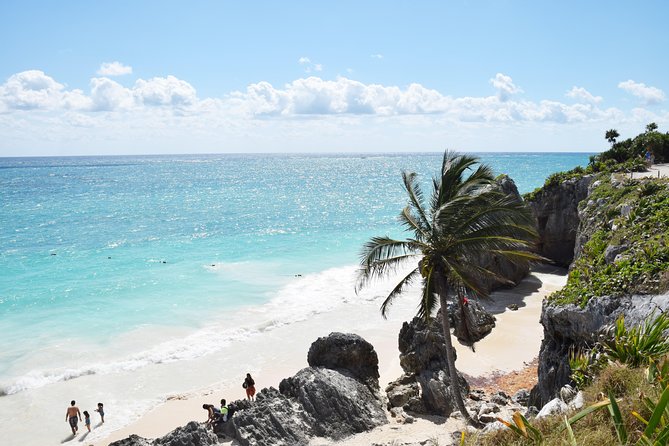Full day trip combine a visit to Tulum archeological site, and swim in a cenote, then explore a limestone cave/reef snorkeling + take a jungle walk.
What’s included
- Bilingual guide
- Round Transportation with AC
- Equipment required for water activities
- Lunch: Traditional Mexican buffet
- (Vegetarian or Gluten Free option available under request)
- Drinks: Fresh fruit water and bottle of water

Tour stops highlight
Tulum Ruins
Discover the Mayan archaeological site of Tulum, world famous for its unique location alongside the Caribbean coastline. Built on a natural outcrop facing the rising sun, the stunning turquoise blue ocean backdrop makes this beautiful site one of the most picturesque in the world.
Mayan Beach Afterwards board local motorboats to reefs where you will explore the fascinating underwater world of the Mexican Caribbean on a leisurely snorkel tour. Brightly colored tropical fish, spectacular coral, amazing rock formations, turtles, rays and unbelievable visibility makes this an unforgettable experience.
Yal-ku Lagoon
Snorkel with multicolored fish in the pristine waters of the Yal-ku Lagoon, located north of Tulum. You can view the bustling marine life from the surface, but we guarantee that the snorkeling experience is way more fun and relaxing. The water is shallow and life jackets are provided, so it’s a great adventure, even for families with kids. Don’t swim beyond the marker buoys, though, as the current farther out can be quite strong.
Cenote
Then journey deep into the subtropical rainforest of the Yucatan to relax, swim and snorkel in the crystal-clear fresh waters of a massive “cenote”, and marvel at the thousands of spectacular stalagmites and stalactites that surround you at every turn
Rio Secreto When arriving to the reserve, one of our guides will provide them with safety measures and the necessary equipment. Before entering the mayan underworld, visitors will tour around the paths of our nature reserve, where they will receive a mayan welcome. You will walk and swim through beautiful natural cristal galleries, during a tour of máximum 1km, lasting approximately 1.5 hours.
Akumal Explore the fascinating underwater world of Turtle Bay on a leisurely snorkel tour in search of 3 of the world’s 7 sea turtle species. Brightly colored tropical fish, spectacular coral, amazing rock formations, rays and unbelievable visibility makes this an unforgettable experience
Sites HISTORY
RUINS IN THE RIVIERA MAYA
In the Yucatec language, Tulum means “wall”, referring to the large barricade that surrounds the settlement. In the Mayan language, Tulum was called Zama, meaning “dawn,” an appropriate name given its eastern location. It seems “Tulum” is the name given to the site by explorers Stephens and Catherwood in 1841. Stephens and Catherwood visited Tulum just before the beginning of the Caste War in 1847, long after the city was abandoned. Their visit to Tulum is outlined in their famous book “Incidents of Travel in Yucatan”. It is important to note that Juan José Gálvez is actually credited with Tulum’s rediscovery in 1840.
Tulum Ruins
HISTORY OF THE SITE
The earliest date found in the site is A.D. 564 , an inscription on a stelae. This places Tulum within the Classic Period, though we know that its heyday was much later, 1200 – 1521 A.D., during the Late Post-classic Period. Tulum was the primary location for the Maya’s extensive trade network with both maritime and land routes converging here. Artifacts found in or near the site confirm contact with Central Mexico and Central America. Archeologists found copper rattles and rings from the Mexican highlands; flint and ceramics from the Yucatán, and jade from Guatemala. Tulum was the hub for international trade and responsible for the distribution of goods into the Yucatan through Coba, Chichen Itza and connecting settlements. Tulum was thought to also be a religious center for priests with the walls protecting the sacred leaders.
Archaeologists have evidence that the population was killed off by the Spaniards when they introduced Old World diseases into the area as a way to destroy the native population. Tulum remained inhabited about 70 years after the Conquest, when it was finally abandoned. Documentation of this demise can be found in the writings of Friar Diego de Landa’s Observations on the Yucatan Peninsula. Local Maya continued to visit the temples to burn incense and pray until the late 20th century.
FAST FACTS ABOUT TULUM RUINS
Tulum site is one of the very few walled cities build by the Maya. These walls are located on only three sides of the settlement as the ocean protects the eastern borders.
The ruins are situated on 12-meter (39 ft) cliffs along the Caribbean
Tulum had an estimated population of 1,000 to 1,600 inhabitants.
The wall around Tulum is three to 5 meters (16 ft) in height, 8 m (26 ft) thick and 400 m (1,300 ft) long on western wall parallel to the sea.
The Castillo (main pyramid/castle) is 7.5 m (25 ft) tall and appears to have built-in stages.
Tulum was a major crossroads of trade from both land and sea managing trade from Central and South America into the Yucatan.
Tulum honored the “diving god” or “descending god” and “the god of the bee”, an important insect for the Maya even today.
During the Caste War, Tulum was occupied by members of the Talking Cross cult
Tulum is the single most frequently visited Maya ruin in the Yucatán Peninsula, receiving thousands of visitors every day.
ABOUT AKUMAL
Located in the heart of the Mayan Riviera, Akumal is one of the most popular diving destinations in Mexico. A lot of historical facts are connected with the name of this village. So, in 1511, after the shipwreck of a Spanish galleon, only 17 people reached the coast of Akumal. All the sailors were captured by the Mayans, and the two Spaniards who survived the captivity quickly became their own among the local residents. One of them, Gonzalo Guerrero, soon married a local princess, they had three children and he completely abandoned Spanish culture and considered himself a Mayan. This was the first time that the blood of a European was mixed with the indigenous people of America. Knowing the tactics of the Spaniards and having learned the military science of the Mayans, Guerrero successfully fought the troops of the conquistadors. Perhaps thanks to the skillful actions of Gonzalo Guerrero, the Mayans survived in contrast to their northern neighbors. Modern Mayan descendants have erected a monument to Gonzalo Guerrero at the entrance to Akumal.
The second surviving Spaniard, Geronimo de Aguila, was rescued by Cortez and became the first Mayan translator and guide for the future campaigns of the Spanish conquerors. The history of the creation of modern Akumal is also interesting. In 1959, a group of Mexican divers raised from the bottom of the sea the remains of a Spanish merchant ship that sank 200 years ago. One of the divers, Pablo Bush Romero, acquired a large plot of land and founded a small diving village. Some of the cannons from the sunken ship are still at the bottom, some are exhibited in the northern part of Akumal Bay, and artifacts and the history of the expedition can be seen in the Puerto Aventuras Museum. Part of his land near Akumal and Xel-Ha Roomero gave the state a national ecological park.
Before the Spanish colonization of the Mayan civilization, this village was a major trade center and port. In translation from the Mayan “Akumal” it is “Land of turtles”. Now on the coast, there are hotels for divers, several centers for underwater travel, coffee shops and stores. Akumal attracts tourists from all over the world with its sandy beaches, beautiful bay with crystal clear water, and many underwater rivers. Snorkeling enthusiasts can swim in the bay with giant turtles and watch the wrecks. Considering that this area is a nature reserve, there are strict rules for vacationers. It is forbidden to touch marine animals and corals.
Akumal is located 100 kilometers from the Cancun International Airport. There is an excellent road along the entire coast of the Mayan Riviera and you can get from the airport to Akumal in one hour. Akumal’s real estate is in great demand among foreign tourists. In Akumal, you can buy a villa on the shores of the Caribbean Sea with a private beach and pool, or rent a small condo in a cozy condominium. Developed infrastructure will make your vacation or stay convenient and comfortable. And secluded beaches and the Caribbean Sea will help you escape from the bustle of the city. There are also a lot of small hotels for divers and downshifting lovers on the coast.
Investments in Akumal’s real estate are very popular among foreigners. “Constant summer”, a large flow of tourists, and the natural uniqueness of the area gives the investor a constant rental income. The average rental income from real estate in Akumal can bring its owner from 5 to 14% per annum.

